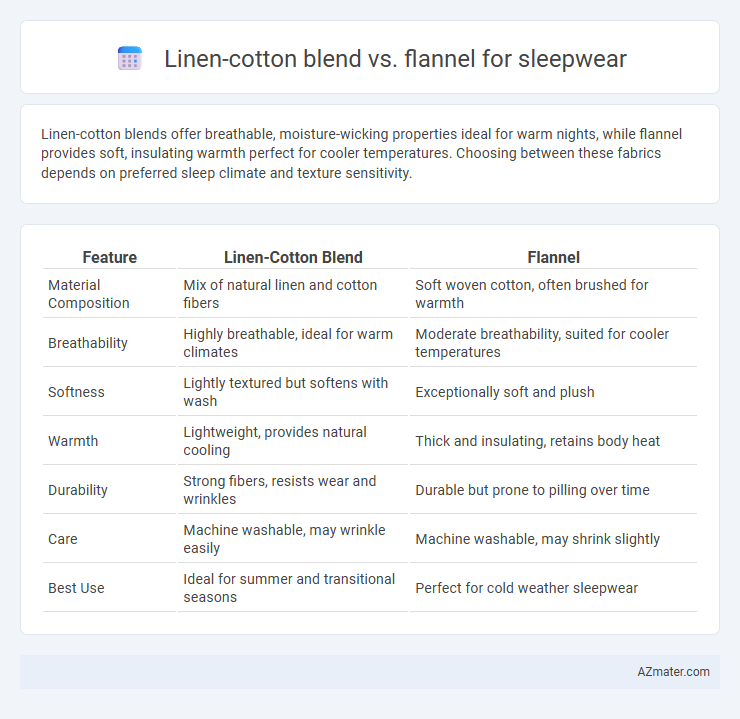Linen-cotton blends offer breathable, moisture-wicking properties ideal for warm nights, while flannel provides soft, insulating warmth perfect for cooler temperatures. Choosing between these fabrics depends on preferred sleep climate and texture sensitivity.
Table of Comparison
| Feature | Linen-Cotton Blend | Flannel |
|---|---|---|
| Material Composition | Mix of natural linen and cotton fibers | Soft woven cotton, often brushed for warmth |
| Breathability | Highly breathable, ideal for warm climates | Moderate breathability, suited for cooler temperatures |
| Softness | Lightly textured but softens with wash | Exceptionally soft and plush |
| Warmth | Lightweight, provides natural cooling | Thick and insulating, retains body heat |
| Durability | Strong fibers, resists wear and wrinkles | Durable but prone to pilling over time |
| Care | Machine washable, may wrinkle easily | Machine washable, may shrink slightly |
| Best Use | Ideal for summer and transitional seasons | Perfect for cold weather sleepwear |
Introduction to Sleepwear Fabric Choices
Linen-cotton blend offers breathability and moisture-wicking properties ideal for warm nights, while flannel provides superior insulation and softness suited for colder climates. Sleepwear fabric choice significantly impacts comfort, temperature regulation, and skin sensitivity. Understanding the distinct benefits of linen-cotton blend versus flannel helps optimize sleep quality and personal comfort.
Overview of Linen-Cotton Blend Fabric
Linen-cotton blend fabric combines the breathable, moisture-wicking properties of linen with the soft, smooth texture of cotton, making it ideal for sleepwear. This blend offers enhanced durability and wrinkle resistance compared to pure linen, while maintaining excellent airflow for temperature regulation throughout the night. The lightweight nature and superior comfort of linen-cotton blend contribute to a restful and cool sleeping experience in various climates.
Characteristics of Flannel for Sleepwear
Flannel for sleepwear is known for its soft, brushed texture that provides exceptional warmth and comfort, making it ideal for cooler nights. Its insulating properties trap body heat while allowing breathability, which helps regulate temperature and prevent overheating. The natural fibers in flannel also contribute to moisture-wicking, maintaining dryness and enhancing overall sleep quality.
Breathability: Linen-Cotton Blend vs Flannel
Linen-cotton blend sleepwear offers superior breathability due to the natural moisture-wicking properties of linen combined with the soft comfort of cotton, making it ideal for warmer nights. Flannel, typically made from tightly woven cotton or wool, provides warmth but can trap heat and reduce airflow, which may cause discomfort during hot or humid conditions. Choosing linen-cotton blend enhances airflow and keeps skin cool, whereas flannel excels in retaining heat for cooler environments.
Thermal Regulation and Warmth
Linen-cotton blend sleepwear offers superior breathability and moisture-wicking properties, making it ideal for regulating body temperature in warm climates or for night sweats. Flannel sleepwear provides excellent insulation and warmth due to its dense, brushed fibers, which trap heat effectively in colder environments. Choosing between linen-cotton blend and flannel depends on whether cooling or warmth is the primary requirement during sleep.
Comfort and Softness Comparison
Linen-cotton blends offer breathability and moisture-wicking properties, making them ideal for warm climates and individuals who prefer lightweight comfort. Flannel, made from brushed cotton or wool, provides superior softness and insulation, perfect for cooler temperatures and those seeking a cozy sleepwear experience. Both fabrics enhance comfort, but linen-cotton blends excel in temperature regulation while flannel stands out for plush softness and warmth.
Durability and Longevity
Linen-cotton blend sleepwear offers exceptional durability, combining linen's natural strength with cotton's softness, resulting in garments that withstand frequent washing and maintain their shape over time. Flannel, typically made from brushed cotton or wool, provides warmth but tends to wear out faster due to its softer weave and pilling susceptibility, reducing its longevity compared to linen-cotton blends. Prioritizing durability and longevity, linen-cotton blend sleepwear is a superior choice for long-term use and consistent comfort.
Care and Maintenance Requirements
Linen-cotton blend sleepwear requires gentle washing in cold water to maintain fiber integrity and should be air-dried to prevent shrinkage, while flannel sleepwear often needs machine washing with warm water and can be tumble dried on low heat for softness retention. The breathable nature of linen-cotton blends helps reduce odor buildup, allowing less frequent washing compared to flannel, which may attract and retain more lint and pilling over time. Proper care of both fabrics extends sleepwear lifespan, but linen-cotton blends generally demand more delicate handling to preserve their natural texture and durability.
Best Choice for Different Seasons
Linen-cotton blends offer breathable, moisture-wicking properties ideal for warm and transitional seasons, making them perfect for spring and summer sleepwear. Flannel provides superior insulation and softness, retaining heat effectively during cold winter months for maximum comfort. Selecting sleepwear fabric depends on seasonal temperature needs, with linen-cotton blends favored for breathability and flannel preferred for warmth.
Final Verdict: Which Fabric Suits Your Sleep Style?
Linen-cotton blend offers breathability and moisture-wicking properties ideal for hot sleepers seeking lightweight comfort, while flannel provides superior warmth and softness perfect for those who prefer cozy, insulating sleepwear during cold nights. The choice depends on personal temperature preferences: opt for linen-cotton blends for cool, airy nights and flannel for plush warmth and softness. Prioritizing these fabric characteristics ensures enhanced sleep quality tailored to individual comfort needs.

Infographic: Linen-cotton blend vs Flannel for Sleepwear
 azmater.com
azmater.com